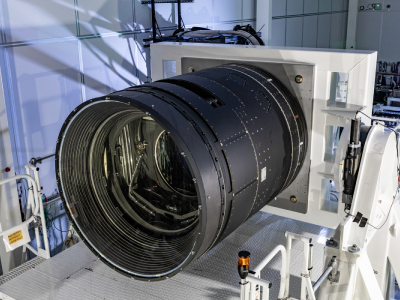
Researchers at the Department of Energy's SLAC National Accelerator Laboratory have unveiled the recently completed Legacy Survey of Space and Time (LSST) Camera. The LSST camera is the largest digital camera ever constructed for astronomy research.
The LSST is a 3,200-megapixel camera that is comprised of 201 individual CCD detectors and weighs over 3 metric tons. Over the next ten years, the camera which will be housed at the Vera C. Rubin Observatory, will be used to collect data on the southern night sky to uncover new insights into our universe. The data will aid future researchers in the quest to understand dark energy and dark matter which makes up nearly 85% of the matter in the universe.
“With the completion of the unique LSST Camera at SLAC and its imminent integration with the rest of Rubin Observatory systems in Chile, we will soon start producing the greatest movie of all time and the most informative map of the night sky ever assembled,” said Željko Ivezić, Director of Rubin Observatory Construction and University of Washington professor.
Once operational, the camera will map the position of and measure the brightness of numerous night sky objects. From this catalog a wealth of information can be gathered, most notably, the camera will look for signs of weak gravitational lensing. Weak lensing can be used to analyze mass distribution throughout the universe as well as how it has changed over time.
"There are so many scientists here at SLAC and around the world who will find something valuable in the data this camera will produce," said Risa Wechsler, a cosmologist who directs the Kavli Institute for Particle Astrophysics and Cosmology at SLAC and Stanford University. "This is an exciting time to be studying cosmology."
Construction began on the camera in 2015, and will be the most complex and robust camera ever designed for astronomy research. A key component to its design, the LSST camera contains three lenses, one of which is 5.1 feet in diameter and is believed to be the largest high-performance lens ever fabricated. The camera also contains 5 filters on board that can be changed in under two minutes, providing access to six different spectral bands across a total wavelength range of 320–1050 nm (near-ultraviolet to near-infrared).
“The Lawrence Livermore National Laboratory is extremely proud to have had the opportunity to design and oversee the fabrication of the large lenses and optical filters for the LSST Camera, including the largest lens in the world,” said Vincent Riot, a LLNL engineer and the former LSST Camera project manager. “LLNL was able to leverage its expertise in large optics, built over decades of developing the world’s largest laser systems, and is excited to see this unprecedented instrument completed and ready to make its journey to the Rubin Observatory.”